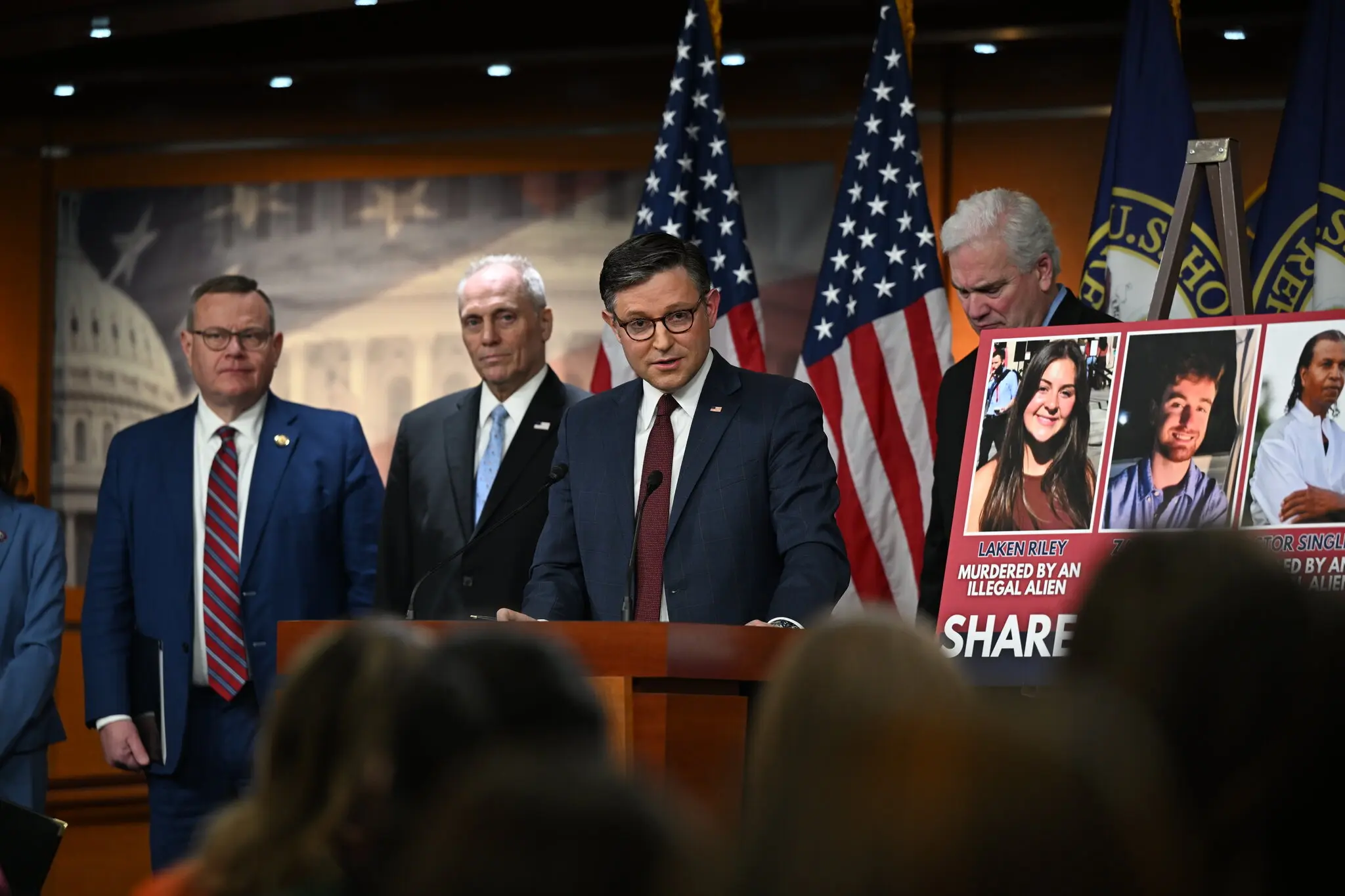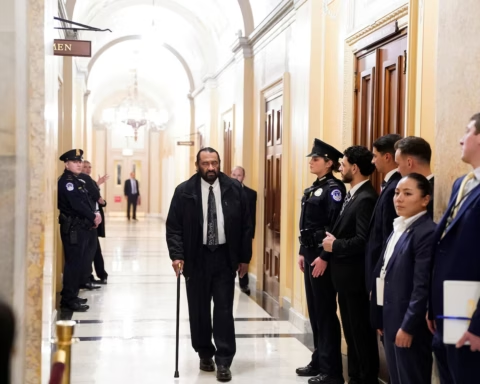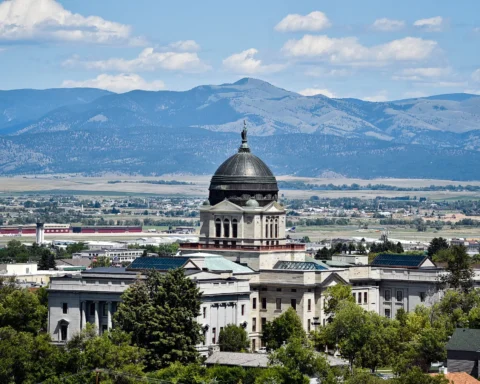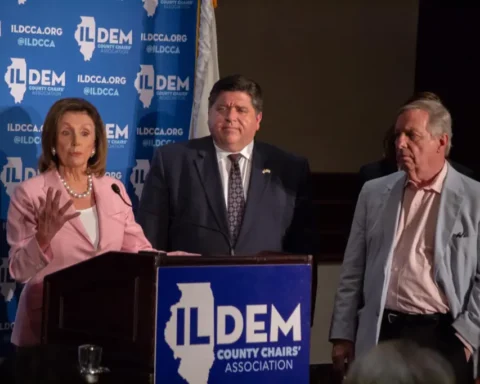Catie Edmondson, Andrew Duehren, Maya C. Miller and Robert Jimison
The House on Tuesday narrowly passed a Republican budget resolution that calls for $4.5 trillion in tax cuts and a $2 trillion reduction in federal spending over a decade, clearing the way for major elements of President Trump’s domestic agenda.
The nearly party-line vote of 217 to 215 teed up a bitter fight within the G.O.P. over which federal programs to slash to partially finance a huge tax cut that would provide its biggest benefits to rich Americans.
It came after a head-spinning hour in which Republican leaders tried to put down a revolt among conservatives who wanted deeper spending cuts, failed to do so, canceled the budget vote and then reversed course minutes later and summoned lawmakers to call the roll.
The chaotic scene underscored the unwieldy path House Republicans have ahead of them as they try to push through Mr. Trump’s domestic policy agenda through Congress over the objections of Democrats.
Approval of the budget plan was a crucial first step for Republicans to smooth the way through Congress for an enormous fiscal package using a process called reconciliation, which allows such bills to steer clear of a filibuster and pass the Senate on a simple-majority vote.
“It’s sort of the kickoff in what will be a four-quarter game, and that very important, very consequential game begins as soon as we get this thing passed,” Speaker Mike Johnson said at a news conference on Tuesday morning ahead of the vote. “This has been necessary because we promised to deliver President Trump’s full agenda, not just a part of it. We’re not just going to do a little bit now and return later for the rest. We have to do it now.”
It almost did not happen. In the minutes before the vote on Tuesday evening, Republican leaders could be seen buttonholing defectors on the House floor, imploring them to support the budget resolution.
When it appeared their efforts had fallen short, they announced that there would be no vote on the plan Tuesday night, and lawmakers quickly filed off the House floor. But minutes later, Mr. Johnson ran back into the chamber, yelled “one more,” and called lawmakers back for the vote.
In the end, Representative Thomas Massie, Republican of Kentucky, was the sole “no” vote in his party. A group of centrist Republicans from competitive congressional districts who had initially balked at the plan over concerns that it would lead to deep cuts to Medicaid, which provides health care to more than 70 million Americans, ultimately fell in line and voted yes.
Another of the holdouts, Representative Victoria Spartz of Indiana, who originally said she would oppose the plan because it would add to the deficit, said she received a “personal commitment” from Mr. Trump to “save health care and make it better.”
“House Republicans moved Congress closer to delivering on President Trump’s full America First agenda, not just parts of it,” Mr. Johnson said after the resolution passed. He told reporters that Mr. Trump’s involvement was a “big help” in getting most Republicans on board.
The blueprint sets the contours for the legislation that House Republicans will now turn to writing. It puts a $4.5 trillion upper limit on the size of any tax cuts over the next 10 years, but does not dictate which taxes should be reduced, a complex and politically tricky question of its own that could take months to sort out.
It also calls for slashing $2 trillion in spending over the same period, without specifying which programs should be cut, though top Republicans have targeted Medicaid and food aid programs for poor Americans. And it directs increases of about $300 billion for border enforcement and defense programs, alongside a $4 trillion increase in the debt limit.
The resolution ties together the lower taxes and spending cuts. If House Republicans ultimately find less than $2 trillion in spending to eliminate, the allowance for tax cuts will shrink by the amount of the shortfall. That means the budget for the tax cut could ultimately drop to $4 trillion if Republicans cut only $1.5 trillion in spending — the floor set in the outline.
Even if they are able to cover the full $4.5 trillion, Republican tax writers have been agonizing over what they can squeeze into the bill. Much of the tax revenue will be consumed by simply continuing the tax policies that Republicans put into place in 2017, which expire at the end of the year.
Extending the 2017 tax law will cost roughly $4 trillion over a decade, while several other desperately desired business tax breaks will eat up another couple of hundred billion. That leaves only a sliver of the budget for the potpourri of other tax cuts that Republicans hope to cram into the legislation, including not taxing tips and lifting the $10,000 cap on the state and local tax deduction.
Achieving near unanimity on legislation that meets the spending targets laid out in the blueprint will also present G.O.P. leaders with a gargantuan challenge. Ahead of the vote on Tuesday, Republicans in swing-seat districts had said that they would be uncomfortable approving a plan that could lead to major cuts to Medicaid and food stamps.
The plan instructs the Energy and Commerce Committee, which oversees Medicaid and Medicare, to come up with at least $880 billion in cuts. While some Republicans denied that they would slash programs for the poor, the amount of revenue they are calling to raise would all but certainly necessitate some cuts to at least one of those programs.
“I’m still making my point all the way to the end about the need to protect the services that are important to my district,” Representative Juan Ciscomani of Arizona said as he left a closed-door meeting of Republicans on Tuesday morning to discuss the plan. “Obviously, this is only the beginning. This is where the real fight actually begins to protect the services that I’ve been fighting for, while also delivering on the promise of slashing down the size of government.”
Many states have expanded Medicaid since the passage of the Affordable Care Act to offer coverage to more low-income adults, with the federal government covering most of the cost of the additional care. But Republicans have discussed cutting off that enhanced federal spending, which could force states to dedicate more of their own resources or stop providing coverage to as many as 20 million Americans.
A fierce debate played out on the House floor ahead of the vote. Democrats argued that Republicans could not claim to be the party of fiscal responsibility while proposing legislation that could add roughly $3 trillion to the deficit, and said the cuts they proposed would savage middle-class families. Republicans countered that if Congress did not extend the tax cuts they passed in 2017, most American families would see their taxes increase precipitously at the end of the year.
Democrats see the Medicaid cuts that are likely to be included in whatever legislation House Republicans put together as a salient line of political attack, akin to their efforts to campaign in 2018 on the G.O.P. efforts to repeal the Affordable Care Act.
“It has to come from Medicaid, it has to come from the A.C.A. premiums,” said Representative Brendan Boyle of Pennsylvania, the top Democrat on the Budget Committee, “because that’s the only place you can find $880 billion.”
At the same time, conservatives in the conference have said they want to see deep spending cuts codified into law, and signaled that they would be loath to lend their vote to a final product that adds to the deficit.
“It’s insane,” Mr. Massie said. “We’re going to increase the deficit with this. Why would I vote for that? You can’t cut taxes without cutting spending, and they’re not really cutting spending.”
Passing the budget resolution through the House is only the first step in unlocking the reconciliation process. Republicans in the Senate will also have to adopt it, though lawmakers there have their own ideas for how to tackle Mr. Trump’s agenda.
Senate Republicans have passed a budget outline for a narrow bill focused on border enforcement and defense, hoping to take a more ambitious swing at tax policy in a separate bill later this year.





